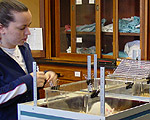Anxiety Models Research Group
Professor Grahn is interested in the neural basis of anxiety disorders and how naturalistic stressors produce anxious behavior. The smell of a predator is a potent stressor for a rat. Exposure to cat odor, for example, causes a rat to hide if it can, and freeze if there is no place to hide, to avoid being noticed. One focus of Professor Grahn's research is to characterize the impact of predator odor on neurons that produce serotonin.The long-term goal of this research is to understand how the serotonin system mediates the effect of predator odor on anxiety-like behavior in rats.
 Shown at left, a rat's brain. In the image above, a rat is observed while exploring the open arm of the elevated plus-maze, a naturalistic situation in which the rat needs to explore a new environment, but remain safe in the enclosed portions of the maze. Drugs that alleviate anxiety in humans promote the rat's ability to explore the open, less-secure portions of the maze.
Shown at left, a rat's brain. In the image above, a rat is observed while exploring the open arm of the elevated plus-maze, a naturalistic situation in which the rat needs to explore a new environment, but remain safe in the enclosed portions of the maze. Drugs that alleviate anxiety in humans promote the rat's ability to explore the open, less-secure portions of the maze.
Want to learn more, or get involved in doing this research? Join the Anxiety Models research group, which meets weekly; contact Professor Ruth Grahn.
Neurobiological mechanisms of psychostimulant-related behavior
Professor Joe Schroeder's research is focused on the neurobiological substrates and behavior of addiction and neurodegenerative diseases. His recent projects related to addiction have been to characterize rodent and zebrafish behavioral models of psychostimulant behavior. Psychostimulants, such as amphetamine and cocaine, produce hyperactivity over time. This hyperactivity can be observed easily, and the neural changes that go along with the change in behavior can be studied.
 In the photo at left, Andrea Rodrigues '06 prepares to inject rats with cocaine, which will increase their movement in the observation chamber. Rats were treated with a drug that impairs normal cell function in the nucleus accumbens to examine if this brain area was necessary for the effect cocaine has on activity.
In the photo at left, Andrea Rodrigues '06 prepares to inject rats with cocaine, which will increase their movement in the observation chamber. Rats were treated with a drug that impairs normal cell function in the nucleus accumbens to examine if this brain area was necessary for the effect cocaine has on activity.
Want to learn more? Contact Professor Schroeder.